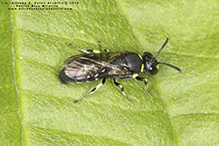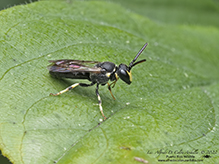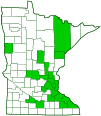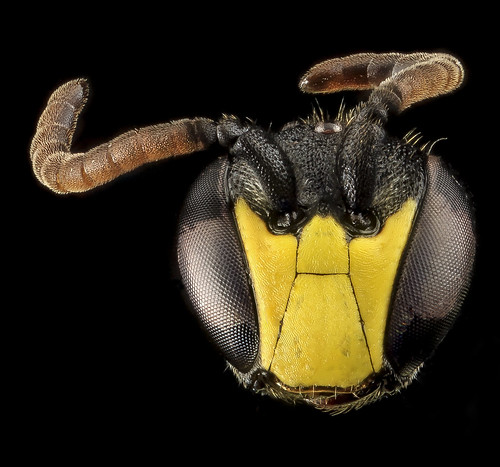modest masked bee
(Hylaeus modestus modestus)
Conservation • Description • Habitat • Ecology • Distribution • Taxonomy
|
|
||||||||||||||
Description |
Modest masked bee is a very small but conspicuous wasp-like bee. It occurs throughout most of the United States and southern Canada but is absent from the Great Plains. Unlike most bees, it is often found in forests, but it is also common in urban areas. The female is 3⁄16″ to ¼″ (5.0 to 7.0 mm) in length. The head and body are black with yellow markings. They have no metallic sheen and are almost entirely hairless. The body is narrow. The plate on the face (clypeus) is black and longer than wide. The face is narrowed toward the bottom. The cheeks (genae) are narrower than the eyes. The area between the clypeus and each compound eye is yellow, creating two yellow, elongated, triangular patches that have been called “devil’s horns”. The area between the antennae bases is black. On the face there is just a single line-like groove extending downward from the base of each antenna (subantennal suture). The antennae have 12 segments. They are brownish-black above and reddish-brown below. The tongue is short. The thorax is deeply and distinctly pitted (punctured). The plate on the thorax just behind the head (pronotum) is short and collar-like. It has a rounded lobe on each side that does not reach the plates covering the wing bases (tegulae). The tegulae are black or brownish-black. On the front margin of the pronotum there is a narrow yellow band that is broadly interrupted in the middle. There is a yellow spot below each wing base. The abdomen is shiny and entirely black, with no yellow markings. The legs are mostly black. There are no pollen-collecting hairs (scopa). The fourth segment (tibia) of the middle and hind legs is yellow just at the base. On the front legs the tibia is yellow just at the extreme base. The spur at the end of the tibia is yellowish. The last part of each leg (tarsus), corresponding to the foot, has five segments. The wings are clear and lightly tinted brown. The veins and the cell (stigma) on the leading edge (costal margin) just before the marginal cell, are dark. The basal vein is straight or nearly straight. There are two submarginal cells. On the hindwing, the lobe at the base (jugal lobe) is longer than the submedian cell. The male is similar but slightly smaller, 3⁄16″ to ¼″ (4.5 to 7.0 mm) in length. The entire face below the antennae is yellow. The tibiae on the middle and hind legs have more yellow. The first segment of each tarsus is yellow, and the remaining segments are reddish-yellow. |
Size |
Male: 3⁄16″ to ¼″ (4.5 to 7.0 mm) Female: 3⁄16″ to ¼″ (5.0 to 7.0 mm) |
Similar Species |
Habitat |
Forests, urban areas |
Ecology |
Season |
May to September |
Behavior |
|
Life Cycle |
The female constructs a nest in wood, often in the spongy cells (pith) of twigs. She lines each cell with a secretion that contains flower nectar and a small amount of pollen. |
Larva Food |
|
Adult Food |
Flower nectar and pollen |
Distribution |
||
|
Sources |
|
| 10/13/2024 | ||
Occurrence |
||
|
||
Taxonomy |
|
Order |
Hymenoptera (ants, bees, wasps, and sawflies) |
Suborder |
Apocrita (narrow-waisted wasps, ants, and bees) |
Infraorder |
Aculeata (ants, bees, and stinging wasps) |
Superfamily |
Apoidea (bees and apoid wasps) |
Epifamily |
|
Family |
Colletidae (plasterer bees) |
Subfamily |
Hylaeinae |
Genus |
|
Subgenus |
Prosopis |
Subordinate Taxa |
|
|
|
Synonyms |
|
Prosapis pennsylvanica Prosapis rugosulus Prosapis rugosulus var fallax Prosopis binghami Prosopis minyra Prosopis nucleolus Prosopis sayi Prosopis supracurta |
|
Common Names |
|
modest masked bee modest yellow-faced bee yellow-faced bee |
|
Glossary
Clypeus
On insects, a hardened plate on the face above the upper lip (labrum).
Gena
In insects: The area between the compound eye and the mandible; the cheek. In birds: The area between the the angle of the jaw and the bill; the feathered side (outside) of the under mandible. Plural: genae.
Jugal lobe
In Hymenoptera: The rear lobe at the base of the hindwing.
Pith
The spongy cells in the center of the stem.
Pronotum
The exoskeletal plate on the upper side of the first segment of the thorax of an insect.
Scopa
A brush-like tuft of hairs on the legs or underside of the abdomen of a bee used to collect pollen.
Stigma
In plants, the portion of the female part of the flower that is receptive to pollen. In Lepidoptera, an area of specialized scent scales on the forewing of some skippers, hairstreaks, and moths. In other insects, a thickened, dark, or opaque cell on the leading edge of the wing
Tarsus
On insects, the last two to five subdivisions of the leg, attached to the tibia; the foot. On spiders, the last segment of the leg. Plural: tarsi.
Tegula
A small, hardened, plate, scale, or flap-like structure that overlaps the base of the forewing of insects in the orders Lepidoptera, Hymenoptera, Diptera, and Homoptera. Plural: tegulae.
Tibia
The fourth segment of an insect leg, after the femur and before the tarsus (foot). The fifth segment of a spider leg or palp. Plural: tibiae.
Visitor Photos |
||
Share your photo of this insect. |
||
This button not working for you? |
||
Alfredo Colon |
||
 |
 |
|
 |
 |
|
MinnesotaSeasons.com Photos |
||
|
||
|
||

Visitor Videos |
||
Share your video of this insect. |
||
This button not working for you? |
||
|
Other Videos |
||
|

Visitor Sightings |
||
Report a sighting of this insect. |
||
This button not working for you? |
||
| Alfredo Colon 6/10/2024 |
Location: Albany, NY |
 |
| Alfredo Colon 8/17/2022 |
Location: Albany, NY |
 |
| Alfredo Colon 8/22/2019 |
Location: Woodbury, MN |
 |
MinnesotaSeasons.com Sightings |
||
|

Created: 2/7/2023 Last Updated: © MinnesotaSeasons.com. All rights reserved. |


